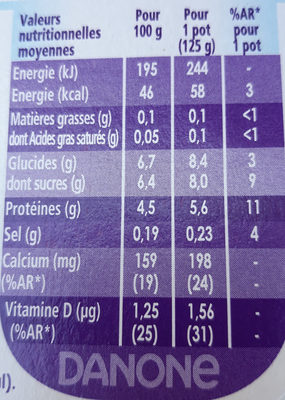Taillefine fruits 125 g x 12 panache - Danone - 1.5 kg
This product page is not complete. You can help to complete it by editing it and adding more data from the photos we have, or by taking more photos using the app for Android or iPhone/iPad. Thank you!
×
Some of the data for this product has been provided directly by the manufacturer DANONE FRANCE.
Barcode: 3033491215285 (EAN / EAN-13)
Common name: Yaourt brassé aux fruits, avec édulcorants, enrichi en vitamine D
Quantity: 1.5 kg
Packaging: Pot
Brands: Danone, Taillefine, Taillefine yog fruits
Origin of ingredients: France
Traceability code: FR 32.464.040 CE - Villecomtal-sur-Arros (Gers, France)
Link to the product page on the official site of the producer: http://www.dan-on.com
Stores: Leader Price
Countries where sold: France
Matching with your preferences
Environment
Packaging
Transportation
Other information
Conservation conditions: A CONSERVER ENTRE +1°C ET + 6°C MAXIMUM
Customer service: D.P.F.F., CS 50149 92565 Rueil-Malmaison Cedex
Report a problem
Data sources
The manufacturer DANONE FRANCE uses CodeOnline Food to automatically transmit data and photos for its products.
Manufacturers can use the Open Food Facts free plaform for producers to access and complete this data, and to obtain reports, analysis and product improvements opportunities (e.g. better Nutri-Score).
Product added on by openfoodfacts-contributors
Last edit of product page on by org-danone-france.
Product page also edited by agamitsudo, kiliweb, packbot, roboto-app, slivi4ka, tacite, yuka.YTdvaEw1MHdsOU1VdmNBVitVN04wT2xleTcyT2ZVV1ROOFFOSWc9PQ.








